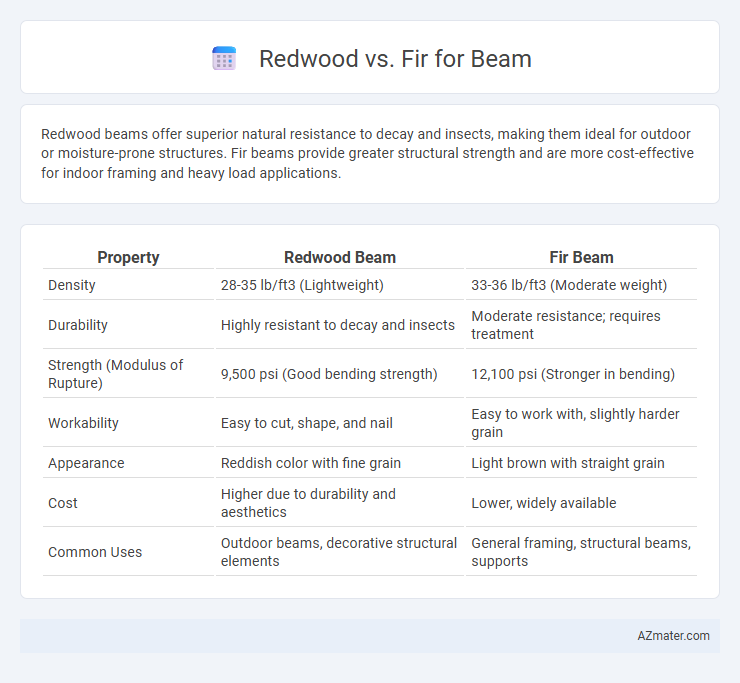Redwood beams offer superior natural resistance to decay and insects, making them ideal for outdoor or moisture-prone structures. Fir beams provide greater structural strength and are more cost-effective for indoor framing and heavy load applications.
Table of Comparison
| Property | Redwood Beam | Fir Beam |
|---|---|---|
| Density | 28-35 lb/ft3 (Lightweight) | 33-36 lb/ft3 (Moderate weight) |
| Durability | Highly resistant to decay and insects | Moderate resistance; requires treatment |
| Strength (Modulus of Rupture) | 9,500 psi (Good bending strength) | 12,100 psi (Stronger in bending) |
| Workability | Easy to cut, shape, and nail | Easy to work with, slightly harder grain |
| Appearance | Reddish color with fine grain | Light brown with straight grain |
| Cost | Higher due to durability and aesthetics | Lower, widely available |
| Common Uses | Outdoor beams, decorative structural elements | General framing, structural beams, supports |
Introduction to Redwood and Fir Beams
Redwood beams offer exceptional durability and natural resistance to decay and insects, making them ideal for outdoor and structural applications. Fir beams are prized for their strength-to-weight ratio, uniform grain, and affordability, making them a popular choice for interior framing and construction. Both redwood and fir provide excellent load-bearing capacity, but redwood's natural oils enhance longevity in exposed environments compared to fir's need for protective treatments.
Strength and Durability Comparison
Redwood beams offer superior natural resistance to decay and insect damage due to their high tannin content, making them highly durable in outdoor and structural applications. Douglas Fir beams exhibit exceptional strength-to-weight ratios, providing excellent load-bearing capacity and stiffness ideal for heavy structural framing. While both woods are commonly used in construction, Redwood provides enhanced longevity in moist environments, whereas Fir delivers greater structural strength for demanding loads.
Moisture Resistance and Decay
Redwood exhibits superior moisture resistance and decay resistance compared to fir, making it a preferred choice for outdoor beams exposed to harsh weather. Its natural oils and dense grain structure help prevent water absorption and inhibit fungal growth. Fir, while structurally strong, is more prone to moisture damage and requires additional treatment to achieve similar durability.
Weight and Workability Differences
Redwood beams are generally lighter than fir beams, making them easier to handle and install in construction projects. Redwood's softer grain structure provides superior workability, allowing for smoother cutting, shaping, and fastening compared to the denser fir. Although fir offers slightly higher strength, redwood's balanced weight-to-workability ratio often makes it the preferred choice for beam applications requiring easier manipulation and reduced structural load.
Cost Analysis: Redwood vs Fir
Redwood beams typically cost more than fir due to their natural resistance to decay and superior aesthetic qualities, making them a premium choice for construction and outdoor projects. Fir beams offer a more budget-friendly option with reasonable strength and workability but may require additional treatment to enhance durability. Choosing between redwood and fir for beams involves weighing initial material costs against long-term maintenance and performance expenditures.
Aesthetic Qualities and Grain Patterns
Redwood beams showcase rich reddish hues with straight, uniform grain patterns, providing a warm and elegant appearance ideal for rustic and contemporary designs. Fir beams feature lighter, creamy tones with a tight, consistent grain that highlights strength and simplicity, making them suitable for modern and industrial aesthetics. Both woods offer unique visual textures, but redwood's vibrant color and distinctive grain make it a preferred choice for ornamental beams.
Environmental Impact and Sustainability
Redwood beams offer superior sustainability due to their fast growth rate and ability to be sourced from responsibly managed forests, resulting in lower carbon footprints compared to traditional fir beams. Fir beams, while structurally strong, often come from slower-growing trees, which can contribute to deforestation and higher environmental impact if not harvested sustainably. Choosing certified Redwood beams supports eco-friendly construction by promoting renewable resources and reducing long-term ecological damage.
Best Applications for Redwood Beams
Redwood beams offer superior durability and natural resistance to decay, making them ideal for outdoor structures such as pergolas, decks, and gazebos. Their rich color and fine grain enhance aesthetic appeal in architectural applications where visual impact is important. Redwood's stability and strength suit load-bearing frameworks in residential and commercial construction, outperforming fir in moisture-prone environments.
Ideal Uses for Fir Beams
Fir beams are ideal for structural applications requiring high strength and stiffness, such as supporting floors, roofs, and heavy loads in residential and commercial construction. Their uniform grain and fewer knots enhance durability and load-bearing capacity, making them preferred for long-span beams and heavy timber framing. Fir's natural resistance to warping and shrinkage ensures stability in beams used in large-scale framework and post-and-beam structures.
Conclusion: Choosing the Right Wood for Your Project
Redwood beams offer superior natural resistance to decay and insects, making them ideal for outdoor or moisture-prone applications. Fir beams provide greater structural strength and a consistent grain pattern, often preferred for indoor framing and load-bearing purposes. Selecting between redwood and fir depends on project requirements such as durability, load capacity, and environmental exposure.

Infographic: Redwood vs Fir for Beam
 azmater.com
azmater.com